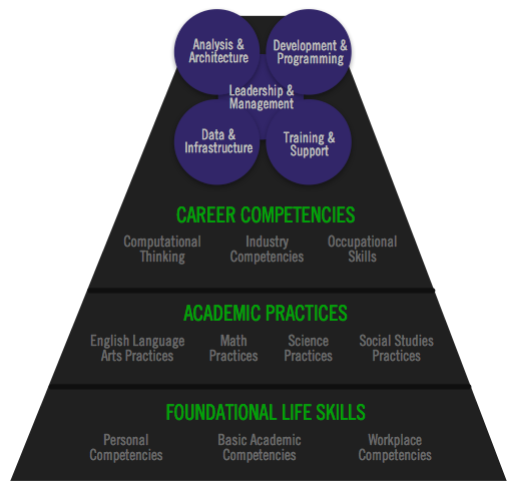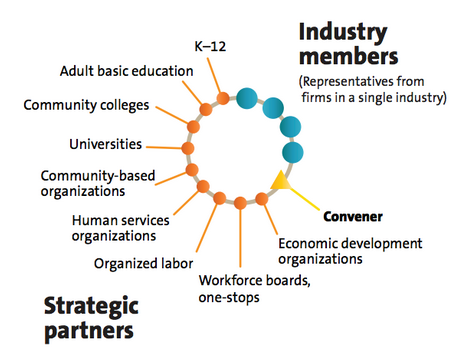Program Director Jay Collier was invited to introduce Project>Login to the Maine State Workforce Investment Board on July 25.
Good morning. My name is Jay Collier, and I am program director for Educate Maine, a business-led education advocacy organization. I lead Project>Login, which is a campaign to help young and adult learners who are sparked by technology to find pathways toward careers in computing and IT.
The demand for computing and IT professionals in Maine is growing quickly. According to DOL projections, Maine jobs in the highest-demand careers will have jumped from between 16 to 22% between 2010 and 2020 and, nationally, these are among the top careers in terms of starting salary, lifetime earnings, and quality of workplace.
At the same time not enough Maine people are preparing for these careers. The number of students enrolling in college computer science degree programs is not growing quickly enough to meet demand, and only a small number of high schools are offering courses in Computer Science.
We are in for a perfect storm, and it will challenge Maine's ability to succeed in the global economy, especially when the UK, Scotland, and China are among the countries that include computing in their national curricula for all K-12 equivalent students.
That is why the CEOs from our largest IT-enabled businesses and public and private universities all recognized this challenge and launched Project>Login early last year. Today, our sponsors are: WEX, Eastern Maine Healthcare Systems, IDEXX Laboratories, MaineHealth, Maine Medical Center, TD Bank, Unum, Tyler Technologies, and the Bangor Savings Bank Foundation. Our academic sponsors are the University of Maine System, Husson University, and Thomas College.
Project>Login's mission is to expand the network of computing and IT professionals and the short-term goal is to help Maine's universities and colleges prepare more students for these careers, indeed, to double the number of graduates within 4 years.
We have three primary activities to support this short-term goal. Our public awareness and outreach initiatives start with a website that contains online dashboards (K-12, adult learners), learning resources, and career information for many different ages of learners, from 3rd graders to adults entering college as well as those who are changing careers. In addition to these resources, we provide news and updates to students, educators, and professionals via social media channels including LinkedIn, Facebook, Twitter, and Basecamp.
We maintain an inventory of over 100 paid internships for college students, including employer contact information because many want to hear directly from the students who have the motivation to reach out to them.
We hold networking receptions on all of our partner campuses to bring together professionals and students and raise awareness of internship opportunities and the competencies that are in demand.
In addition, our higher education partners are developing new and enhanced programs and curricula in computing and IT, such as a new Bachelor of Science degree in Information Technology at USM and three community colleges through an articulation agreement. And we're pleased to promote and support Maine community colleges' new certificates and associates degrees as part of their $13 million dollar TAACCCT grant.
But, even when all of Maine's colleges and universities double their graduates, it still won't be enough to meet demand.
So, in addition to our work with higher education, in our second academic year, we're building strategies for workforce development and K-12 student engagement to help even more young and adult learners who are sparked by tech prepare for these careers.
We know students who are sparked by tech move along pathways of deepening engagement, from curiosity to career, through discovery, collaboration, exploration, study, and career preparation. Yet for most Maine students, opportunities to connect their curiosity with deeper learning are often limited.
So, we've been identifying and promoting learning opportunities, from online DIY tutorials to after-school programs and summer camps to computer science courses to help them find their way forward.
Specifically, we've been promoting DIY tutorials and courses to help students discover, first of all, if they're interested in tech. As an engaging introduction, the national Hour of Code campaign was created by Google, Microsoft, Apple and has reached 36 million students around the world. (To find out what it's all about, go to Code.org click on start, and try out the maze game that teaches the fundamentals of Computer Science. It's a great start for all ages.) Khan Academy is another popular collection of free online self-directed courses in math and computer science in use by teachers and students around the world. And Codecademy has free tutorials for young and adult learners in Javascript, PHP, Ruby, Python, and more.
Then, to support deeper exploration and collaboration, we helped the annual student tech conference which brings over 800 students to the University of Maine transform their workshops, this year, to a focus on coding and innovation. Over half of the participants in our own sessions were girls, which is important: if a larger percentage of young women and girls saw themselves in this profession, we'd go a long way toward meeting demand.
We've also been supporting the Maine Math and Science Alliance in their quest to secure funding for professional development in computing for teachers around the state.
However, until computing courses are available in all schools, we've already started building a collaboration to bring tech mentors to after-school programs, and we're working with colleagues from the MIT Media Lab, Maine's 4H STEM program, the Maine Afterschool Network, and directors at 21st-century Community Learning Centers.
But even though this work in K12 is exciting, it is a longer-term commitment to fill the pipeline. It won't necessarily meet our immediate workforce needs.
That is why an important new area of focus for the coming year is workforce development: specifically helping adults who are engaged by computing and IT to find the careers that best match their interests and abilities.
To that end, we started our investigation with a deep dive into data about the 25 computing and IT careers being tracked by the Department of Labor. These fall into about 5 main groups:
Early this year, we gathered and published resources about these career groups, including wages and predicted growth, knowledge, skills, education, jobs, and even the kind of personalities that are well-matched to each career group. We regularly update this information on our website and present it at career fairs.
However, what everyone asks students, and also educators, counselors, and parents alike is this: What is the right career for me? What is really needed to help me get ready for that interesting career? We live in an era when people are thinking more deeply about the return on their investments of tuition and time when they consider college; it's too expensive not to do so.
Thanks to Gail Senese, we adopted the national DOL Competency model and we've been integrating it with more specific knowledge used in this profession. We see the competencies model as a three-layer pyramid of building blocks for every person: first, foundational life skills, then, a toolbox of academic practices, and, finally, more specific career competencies in computing and IT. Even though many of you already work with this model, I'll briefly describe the way we're using it.

At the base of the competency pyramid are foundational life skills. These are the abilities that help people thrive in their personal, school, work, and community lives. They include:
Whether you call these soft skills, 21st century skills, or Habits of Mind, we've seen research indicating they are important indicators of success in college and beyond. We also know that they are important across all jobs and in all industries based on MDF's quarterly jobs reports built on Burning Glass research.
On top of those foundational life skills, we know that the academic practices within the disciplines of English Language Arts, Math, Science, and Social Studies all of which focus on problem solving and use each discipline's approaches are also important resources across many careers.
Finally, at the top of the pyramid are the career competencies that help people prepare for the workplace. These include Computational Thinking which is a a problem-solving approach using the power of computing to solve meaningful and relevant problems and skills from O*net and industry certifications that are aligned to each career.
So, we have gathered knowledge from the DOL and DOE about the competencies leading toward success in computing and IT careers, and we have been sharing them widely with educators, counselors, students, and policymakers.
However, our current knowledge about which of these careers are in demand is long-term, usually in terms of the next 3 to 7 years. We're interested in finding ways to identify needs over the next 12 to 24 months, which would provide enough time for Maine people poised to fill those positions to gain just-in-time education and career experience.
So that brings us to the sector partnership model implemented in other states, supported by the National Governor's Association, and being investigated by this board.
We understand that the process includes convening cross-constituency roundtables to determine immediate workforce needs and to identify and fund targeted educational opportunities and career experiences for promising future employees.

We're pleased to see that this process aligns well with the vision of Project>Login's founders: to bring together partners across business, education and government to connect qualified employees with high-demand computing and IT positions.
To move forward with this work in workforce development, we would benefit from expertise in preparing for, and convening, a formal, focused cross-sector partnership, and your access to targeted funding for the learning opportunities that best meet these immediate employment needs.
I look forward to learning more from you about this model. Together, we can help Maine businesses including but not limited to our sponsors to find the Maine employees who can help them stay competitive in a global marketplace.
Thank you for your time and interest.